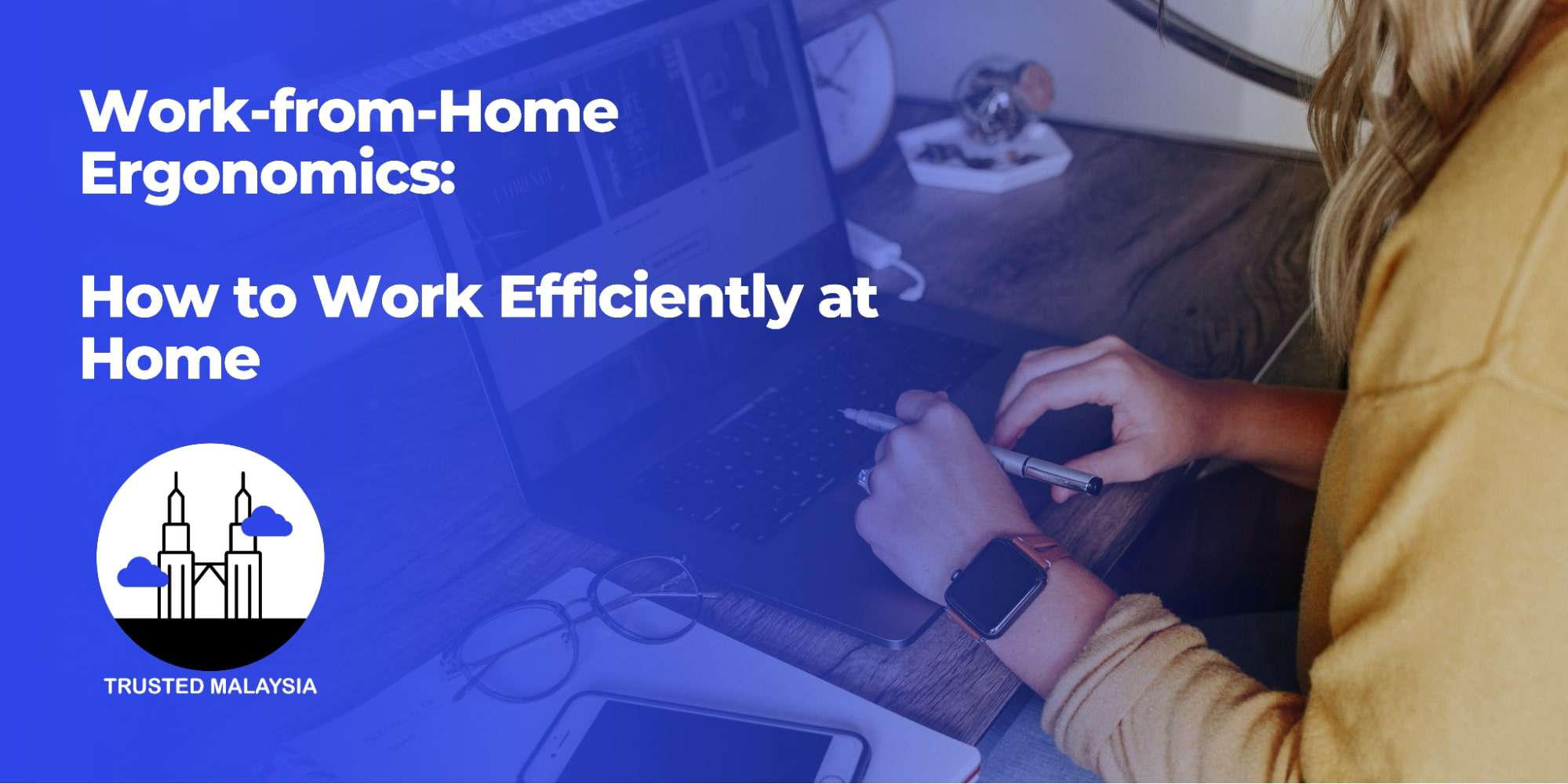Work-from-Home Ergonomics: How to Work Efficiently at Home
Given the unpredictable and dire nature of the virus, most business owners have adopted a full-time remote work model for their staff members to sustain the company.
That’s a huge change from working in the office with complete furniture and equipment to using your own stuff at home. Thus, it can be challenging to work efficiently at home due to the lack of office space.
As a matter of fact, Global Workplace Analytics reported that over 20% of the global workforce is now working from home due to the COVID-19 pandemic. Furthermore, 76% of global employees prefer to continue their work-from-home setup.
That’s why it’s essential to find the right setup because sitting for 8 hours in front of your workspace will result in poor physical health.
So, in this guide, we will tackle the importance of proper ergonomics, the rules of an ergonomic setup, and some practical tips to stay productive and healthy for your home-based work.
The Importance of Proper Ergonomics

You may often hear the term ergonomics when buying a product or working at an office. With the former, it means “parts or qualities that make a product easy to use.” And with the latter, it means the practice or study of working efficiently and safely in the office.
Here, we will be using the second definition when we mention ergonomics. Now, to be efficient in the office, it goes without saying that you should feel comfortable and relaxed the entire time you’re working.
In a work-from-home setup, ergonomics is the practice of setting up a workspace in your home to reduce the risk of musculoskeletal injuries and other health issues.
Moreover, poor ergonomics while working from home can lead to physical and mental fatigue, eyestrain, headaches, and neck, shoulder, and back pain.
Ergonomics is important for work-life balance. You can’t give your best at work if you feel pain and body aches due to improper posture in front of the computer, handwriting a letter, or speaking on the phone.
In addition to having the correct posture, you might also need to alter your work setup if you feel muscle strains or discomfort after just a short while typing on your computer.
In fact, there have been increased reports of WFH people developing lumbar pain and weight gain, based on the research of the Journal of Occupational and Environmental Medicine.
Because of the constant seating, your spine is the most affected part of the body. Additionally, wrist, leg, neck, and shoulder pain are also culprits of an incorrect posture whilst working.
As a result, people might not be able to work any longer, whether they stand or sit. And to treat or alleviate the painful symptoms they feel, they go for a massage, physiotherapy, or chiropractic adjustment.
Keeping the Spine in a Neutral Position

You shouldn’t feel any pain and discomfort whenever you work at your desk in front of your laptop. Since lower back pain is the most common symptom for people working at home, focusing on spine alignment first and foremost is vital.
Getting the proper posture enables other parts of your body, such as the neck, shoulders, arms, and legs, to be in the correct position as well.
So the best thing to do is to keep your back straight. But it doesn’t have to be ramrod-straight – just natural and comfortable enough for your spine.
To show you what we mean, if you see a spine diagram of a person, you will notice that it isn’t utterly straight but curved, almost like an S, which is natural. And because it’s natural for the body, it’s easier to maintain a correct spine alignment.
The right posture means you don’t slouch, lean to the side, or be too far from the laptop while typing. Although sometimes, you may not notice that you’ve been doing it until you suddenly feel tired or weak.
Thus, you may have to adjust your back posture as you work to find the lightest and most comfortable position. If you feel any pain, remember to keep your back straight and natural, whereas if you feel healthy and comfortable when working, then keep doing that.
Check out the simple diagram below of having a neutral spine, or in simple terms, sitting correctly.
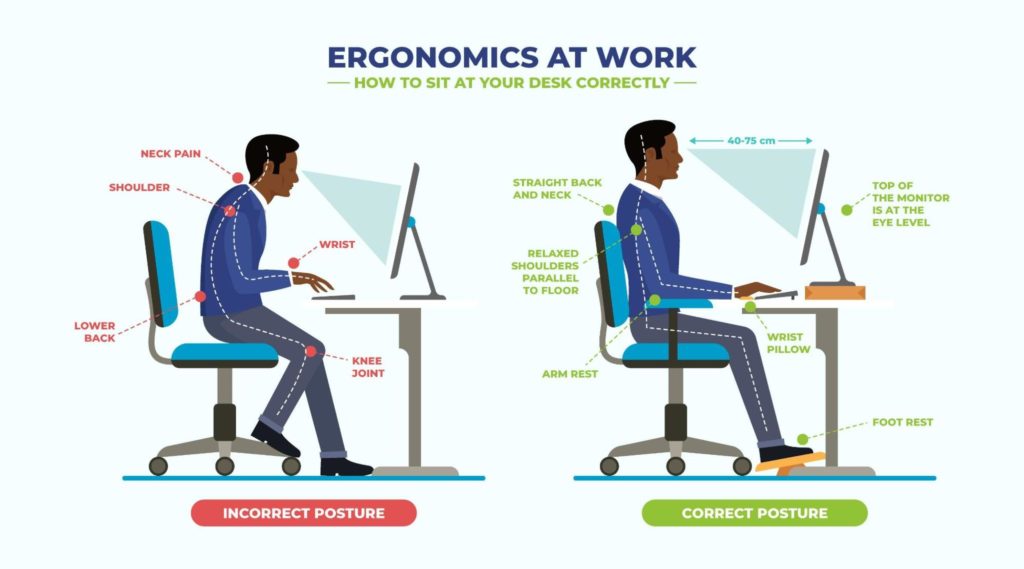
The Best Ergonomic Setup for Remote Work
We all have unique home layouts, and there can be a lot of places or areas to choose from to do our work.
The importance of an ergonomic setup must be recognized wherever you decide to work, especially if you have constant distractions at home from family, kids, or pets.
You might be surprised that setting up an ergonomic workspace has several factors. It’s understandable because, before work-from-home setups, we all relied on our company’s offices that come with complete equipment.
But now, many people choose to work from home even when there’s no complete ergonomic equipment.
A survey conducted by the American Psychological Association found that 65% of people who work from home feel more productive than when they work in an office.
That’s why having a completely ergonomic home office is vital to remain productive despite the many distractions – like your neighbors yelling or dogs barking.
Further, setting up an ergonomic workspace includes having comfortable chairs, a monitor screen at eye level, proper table height, and good lighting.
So here are the guidelines for making your workstation at home cozy, effective, and pain-free. Let’s start with choosing the right type of desk for your workspace.
Desks
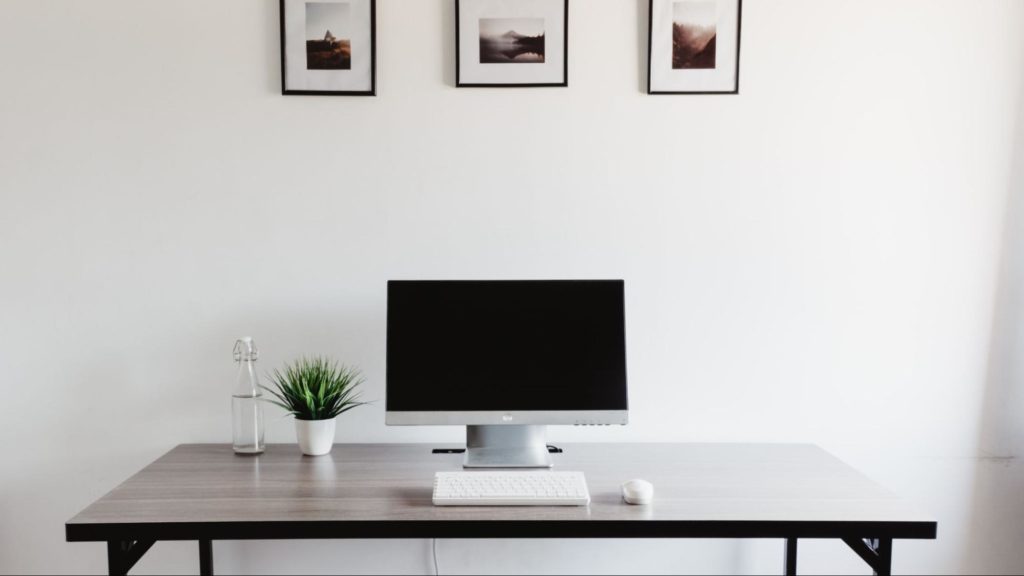
You can work on any sturdy desk, whether in your dining room, bedroom, or terrace, so long as it allows you to be in the correct posture. But choosing the right computer desk can be challenging.
So, for an ergonomic workstation, the desk should be the right height for you to work comfortably and have enough space for your work materials.
Ideally, the desk should allow you to fit your thighs, knees, and feet underneath. Also, you don’t have to squeeze your legs just to fit them under the desk.
Then, check the height. The table’s edge should be level or slightly below your bent elbows as you type.
However, if the table is too high, you can get a lower seat or adjust your office chair. But if you don’t have an office or gaming chair (a popular choice for office ergonomic), you can improvise by putting a pillow or some books atop your seat.
Seats
No matter the kind of chair you have at home, you have to sit in the correct posture. As we mentioned, this means keeping a natural and straight back while working.
The chair should be adjustable to fit your body and provide back and lumbar support to avoid hip, knee, and leg pain.
Some chairs also come with a headrest and lower back cushion for ergonomics. The lower back cushion follows the natural curve of your back to prevent any painful sensation affecting your work stamina and concentration.
But if yours doesn’t have a lumbar support feature, you can go DIY. Make your own ergonomic chair by putting a small pillow or rolled towel on the chair against the small of your back.
Additionally, check that you keep your feet planted on the ground. And if you need to elevate the chair where it’s high enough that your feet dangle, you can simply use a footrest or a stool.
Both of these chairs have several advantages regarding flexibility. These include aligning your posture, shifting weight, preventing back strain, reducing fatigue, and easing ankle, foot, and thigh pain.
Moreover, you need to check if your arms are comfortable on the sides or while resting on the armrests. If not, you can change the armrest height to a level where you can type easily or when lounging on the chair.
You can make these adjustments from top to bottom, bottom to top, or without any order because it depends on one’s height and comfort.
It’s good news that office and gaming chairs have become popular purchases for home office setups, resulting in a broader price range. So, choosing the right one has become easier because of the different prices, ergonomics, and comfort levels.
@stancephilippines ergonomic chairs are game changers! Shop our wide variety of ergonomic chairs on stancephilippines.com! 🛒 #stance #wfh #ergonomicchair
♬ me softly with his songgg – spedupsongshavemyentire❤️🩹
Types of Ergonomic Chairs
Monitor
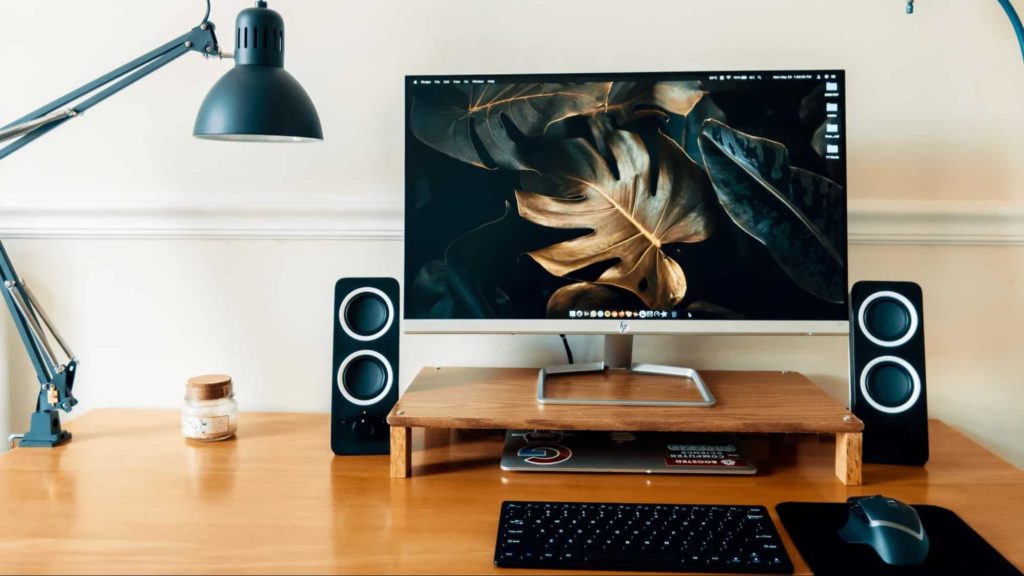
When you’re working in front of a computer, you need to have an ergonomic setup for the monitor, too. The same rule applies to desktop computers and laptops, irrespective of screen type and size.
First, you should ensure that the top of the monitor is on or slightly below your eye level.
Furthermore, you should be able to look at the top third portion of the screen with your eyes without needing to bend your neck.
Doing this allows you to keep your neck and back straight at all times as you work. Still, if your monitor is too low, you can adjust your seat or put a riser or a pile of books under it.
Currently, laptop stands are popular for home offices. A sturdy one provides flexibility because it allows you to adjust the height level of the laptop based on your level of comfort.
You can also tilt the laptop back to 10 or 20 degrees to reduce the screen glare. In addition, it gives a better posture while you send emails, write articles, or start a Zoom chat with your superior.
Keyboard
When it comes to keyboard placement, your elbows should be level with or slightly below the table’s side. Your wrists should be relaxed and nimble while typing, and your arms shouldn’t be restricted in movement or feel pain and discomfort.
Apart from those aspects, you have to be aware that each keyboard is made with different tilts.
What we mean by this is that some slope up to the top portion, whereas others have a flat or even a negative angle (slope down from the bottom), promoting better wrist position as you write.
Now, if your arm and wrist positions are correct, yet you still feel aches when typing, the problem may be on the keyboard itself. Fortunately, we have some tricks that you can do to alleviate this: put rice in a sock or use a small rolled towel to give good support to your wrists.
Mouse
For people who use a mouse for their computer or laptop, it should be next to your keyboard and slightly above it. Also, it should be on the side of your dominant hand and within easy reach.
But if it feels a bit on the low angle, getting a mouse riser can be helpful. This is kept in place on your desk or keyboard tray and allows you to point, scroll, and navigate websites without effort, although it depends on whether or not the user is comfortable with it.
Furthermore, ergonomic mice (also known as vertical mice) are slowly gaining popularity (even in the gaming community). Its benefits are keeping your hand in a natural position, thus preventing wrist pain, and needing less grip strength.
Granted, it may take some time to get used to (it looks unique, too). But it provides fewer movements for your wrist and comes in different types and sizes depending on one’s hand and grip.
Lighting
Not many consider lighting an essential part of home office ergonomics. But good lighting can increase productivity because it can help your mind stay active.
Natural light can help boost productivity, and stabilize your mood, especially if the view outside isn’t shabby. But not everyone has the luxury of having a home office setup with natural lighting.
Instead, try to avoid working under direct light. It can harm your eyes, cause headaches, and reduce productivity.
Therefore, it’s best to work in indirect lighting. You can do this by using lampshades to avoid harsh light and by illuminating your home office properly through combining warm and cool light bulbs.
Moreover, lampshades can avoid glare on your computer screen. Also, direct lights can cause shadows on your monitor, which can hinder work and cause neck and back pains.
In addition, you can try combining natural and artificial lights for workspaces where little sunlight comes in. Even little sun rays can help your mood for the day, resulting in a better work day at home.
What are the average costs of an ergonomic home office setup in Malaysia?
Ergonomic workspace can be expensive, especially if you don’t have some equipment already available at home. Here, we’ve compiled a list of the average costs of an ergonomic work-from-home office to give you a better idea.
But it’s important to keep in mind that these prices will depend on the type of equipment, brand, and features.
The 5 Best Ergonomic Practices for Working at Home Efficiently
You have to accustom your body to the rigors and challenges of working at home, especially now many employees very much prefer home office setups.
In fact, a survey conducted by the National Bureau of Economic Research found that employees who work from home are 13% more productive than those who work in an office.
Apart from your body posture and equipment, here are some simple things you can do to increase your work performance:
WFH Setup: Ergonomic Checklist
☐ Maintain the correct body posture
☐ Have a computer table that has ample space for your work materials
☐ Use a chair that supports your back and has clearance underneath the table for your knees and legs
☐ Position the top of the monitor on or slightly below your eye level
☐ Put the keyboard and mouse at the correct area that doesn’t restrict your arm movements
☐ Have your work materials at the table neatly
☐ Adjust the lighting to prevent glares on the monitor screen
☐ Use the 20/20/20 rule
☐ Avoid working for long periods of time
☐ Take much-needed breaks and stretch your body
☐ Stay hydrated
☐ Don’t skip breakfast and lunch
☐ Keep an exercise routine
1. The 20/20/20 Rule
Working with your eyes glued to the screen isn’t healthy. It makes your eyes dry, irritated, and heavy, making you less effective and causing a massive headache.
So whenever you work at your computer, remember the 20/20/20 rule. This means you should look away from the screen 20 feet away, for 20 seconds, after every 20 minutes of working to rest your eyes.
Doing this allows you to work longer and more efficiently during the week. This way, you can also take care of your eyes and even possibly prevent a trip to the eye specialist and save big bucks.
2. Incorporate movement into your work routine.
Working from home is a sedentary lifestyle where you can burn significantly fewer calories than going out to the office, leading to increased weight and stress.
For this reason, you need to have a consistent exercise schedule several times a week. Even if you have a full workweek, you can always give time for it for as short as thirty minutes, about twice or thrice a week.
Running and skipping rope are great exercises that can refresh you in the morning and prepare you for the demanding tasks of the day. By engaging in physical activity, your mind will work faster and sharper, and most of all, you will feel good.
3. Take frequent breaks from work.
Taking frequent breaks from work helps a lot. This way, you won’t exhaust yourself from the job you have to do, but you can rejuvenate yourself instead, which raises your productivity.
Additionally, you can take a break every thirty minutes to an hour of working. And it won’t take long as you can just stand up and grab a glass of water, do a quick chore, walk around the house, look at the view outside, or do other simple things.
Furthermore, you can set aside a 5-minute yoga or pilates schedule, run on the treadmill (if you have one at home), run an errand, meditate, or take a quick nap if you’re tired.
4. Use a standing desk.
Sitting for too long can cause you to feel back and neck pain, heaviness, or muscle weakness. You might also begin to feel that you are stuck in your job routine.
To deal with those issues, you can stand and type away at your computer using a standing desk. In addition to giving yourself a change in your workspace, you can burn extra calories, albeit only slightly compared to working while seated.
The catch here is that a standing desk can double as a sitting desk, owing to modern ones’ adjustable features.
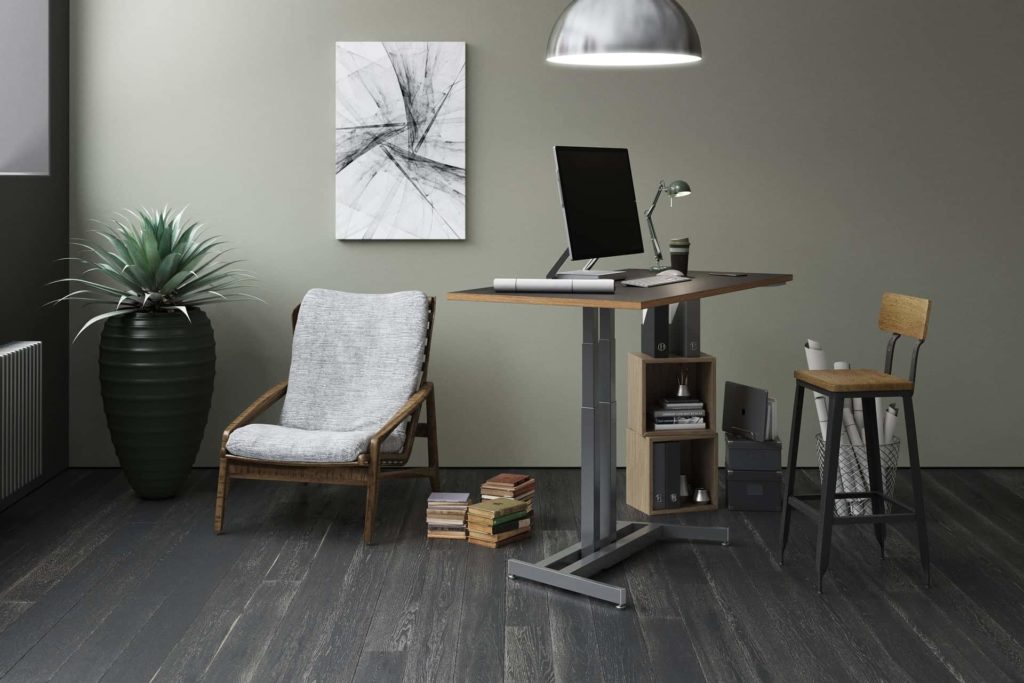
Although these features mean they can be pricier than a regular computer desk, purchasing a standing desk can be worth it since it can incorporate movement while working.
Now, don’t forget that your back must be straight and natural when using a standing desk. And the same rule applies to monitor, keyboard, and mouse placements.
Also, you may have to test and adjust which posture is the most comfortable for you. And we advise standing for short periods first, like doing 30 minutes a day, and increasing the duration a bit from there.
But if you want to increase your movements further, you can get an under-desk treadmill so you can walk while working. The good thing about this is it eliminates sedentary activity and adds to your daily exercise routine.
@thejunglebadger Wfh and workout at the same time! 👩💻 🏃 @flexispotuk #FlexiSpot #FlexiSpotUK #wfh #standingdesk
♬ original sound – Best Online Finds
5. Adjust to your work environment
Make sure that you’re comfortable in the WFH environment you’re in. Bring at least two face towels to wipe dirt or wet hands, so you don’t have to go to your room’s closet frequently.
Put a tumbler (make sure it’s closed, though) or a glass of water beside you to stay hydrated and energetic throughout the day so that you can finish your work at hand.
Also, put a towel on your back or change your clothes quickly if they are soaked in sweat to prevent coughs and colds. Remember that physical health is an important part of the work-life balance.
Bad Ergonomics: 3 Habits to Avoid When Working at Home

We talked about good ergonomics to help you with flexibility in your home office. But what about the bad ergonomics many people have slowly and unknowingly incorporated into their daily lives?
Bad ergonomics can take a toll on your physical and mental health. That’s why recognizing these are vital because they don’t provide any benefits but only heighten the possibility of a trip to the hospital.
1. Incorrect Workstations
An incorrect height of the workstation and chairs can result in bad postures, like prolonged bending, kneeling, and twisting. These awkward and repetitive positions can cause muscle strains and poor blood circulation.
Moreover, these can result in injuries and musculoskeletal conditions, which can affect your daily life.
2. Working in the Same Posture or Awkward Positions
Having the same or repetitive posture for a long time can cause strains, resulting in trauma in your body. It can also cause fatigue, which will give you headaches and dizziness.
Incorrect posture can also result in carpal tunnel syndrome, which can result in surgery for severe cases. Despite getting an operation, some symptoms won’t go away for some people (weakness, numbness, tingling of the hands).
3. Frequent Use of Force
Excessive use of force, such as lifting, pushing, and pounding, can lead to muscle strain and damage. Adding this to sitting in awkward positions for a long time can cause physical stress.
Repetitive motions can cause injuries, and many will cause lifetime symptoms that will affect even simple day-to-day activities.
Benefits of Working from Home
Since the pandemic, working from home has been popular and preferred by many people. Slowly, people have realized the many benefits of working from the comfort of their own homes.
As a result, many have started looking for completely remote jobs. So, let’s check some of the benefits of working from home.
1. Flexible Schedule and No Commutes
Working from home has provided flexibility in day-to-day life. You won’t have to worry about waking up early to get ready and rushing through the commute.
Additionally, flexible hours allow many people to control their own time, resulting in a better work-life balance. They can do their work while still having extra time for chores, doctor’s appointments, and self-care without asking for a leave of absence.
2. Increased Productivity Levels
Work-from-home setups have resulted in increased productivity because of the reduced distractions of commuting. Besides that, you can choose your own timetable instead of going by your boss’s or colleagues’ schedules.
3. More Savings
The lack of commute, coffee and lunch purchases, and no longer needing to buy office attire helps a lot in saving money. You can save by cooking food in your own home instead of buying one every day.
Moreover, parents can save on childcare costs because they can monitor their kids at home. And the lack of a commute means they can observe their kid’s schoolwork even more.
4. More Time with Loved Ones
One of the best things about working from home is the increased time with your loved ones. Aside from having time for yourself, you can still spend extra minutes with your family because you work on your own terms.
Conclusion
Workers can work from home safely and efficiently with the proper posture and the right equipment. The advice and tips we’ve shared here are simple to do and easy to incorporate into a daily habit.
By following them, you can face your computer feeling motivated, healthy, and happy because of a work-life balance. It’s also because you know how to care for your body, particularly your eyes, lower back, shoulders, and neck.
